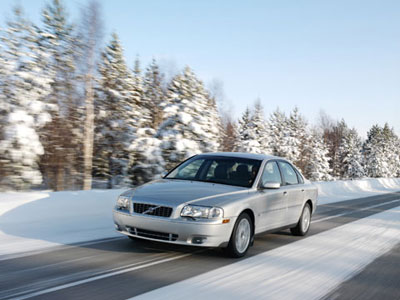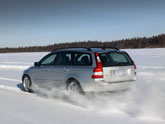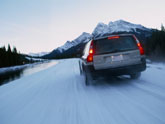Recent Articles
Popular Makes
Body Types
How to Prepare for Winter Driving
Inspecting Your Winter Ride

Icicles sparkle in the sunlight of a beautiful, clear winter morning. A foot of new snow has fallen overnight, blanketing the landscape like a clean sheet of paper, and the sounds of a crisp breeze fill the air. After warming up a cup of coffee, it's out to the driveway to warm up the car and head off to work. But wait -- the car won't start. And that fresh scent of new-fallen snow has been replaced by the smell of gas. Several more twists of the key, accompanied by the muttering of a few angry words, and the engine finally grumbles to life. Unfortunately, the heater doesn't work. No worries - the windows will probably clear up within 20 miles or so. You put the car into reverse and give it some gas, only to hear the spinning of tires coupled with the smell of burning rubber.If only that car had been winterized. Preparing for winter is an annual ritual in most parts of the country, and a lot of attention is paid to ensure that the family stays warm, heating costs stay low and snow gets cleared. Goretex boots and Thinsulate-lined jackets are pulled from storage and lawn furniture is stored in the garage. But cars often don't get added to that to-do list. Despite frigid temperatures or several inches of fresh powder, vehicles are expected to operate safely on a moment's notice. To limit problems this winter, consider the following tips before the snow flies.
Tips
· Buy a tire-tread depth gauge at the local auto parts store, and check all four tires to make sure they have plenty of tread. Snow, slush and water are channeled away from the tires through the treads, allowing more tire to be in contact with the pavement. Worn, bald tires lose their ability to move the muck out of the way, and the result is less traction on snow and hydroplaning on standing water. If the tire tread depth is 1/32 of an inch or less, the tires should definitely be replaced.. Also check the tires for proper inflation and cracks. Recommended tire inflation figures should be listed on the tire as well as inside the driver's door jam. If a tire exhibits excessive cracking (most visible in the treads), that tire is compromised and replacement should be considered. · Inspect the spare tire (if equipped). Don't wait to discover a flat or damaged spare when it's needed most. · Consider the purchase of winter tires before the season begins. Studded and regular snow tires are often used on front engine/rear-wheel-drive vehicles to improve traction in inclement weather conditions, and extra weight is sometimes added to the trunk to improve traction - but in today's day of traction control and electronic stability systems, this is probably not needed.Be aware that state laws usually dictate if and when snow tires may be used. · Get the car in for a tune-up, if necessary. Nowadays, most cars don't need tune ups, but it's wise for older models with carbureted fuel systems. However, that isn't a guarantee of a problem-free winter, and many other vehicles (new and old) don't feature the same maintenance schedule. If there's any question about a car operating properly, have it checked out - being stranded in the cold because of a mechanical breakdown is seldom fun. · Make sure the heater and defrosters are working properly. It may seem obvious, but malfunctioning heaters and defrosters may go unnoticed for months, only to be noticed on the first cold morning of the season. Driving with a fogged windshield or rear window is dangerous and could lead to an accident. · All exterior lights need to be checked. Limited visibility is a major problem with winter driving, and faulty headlights or brakelights makes seeing a vehicle, or understanding a driver's intentions, that much more difficult. Signal and reverse lights should also be checked. · Fix any exhaust leaks. Vehicle windows are usually closed up tight when it's cold or wet outside. If there's an exhaust leak, carbon monoxide could linger in the car and cause harm to the passengers. · Build a winter driving survival kit, including items such as an ice scraper and warm clothing. Carry these essentials in the trunk in case of bad weather or an emergency. · Oddly enough, a failing radiator can cause a car to overheat even on the coldest days. Be sure your car's radiator anti-freeze is suitable for extreme temperatures. Most full-service oil change shops will include a check of your car's anti-freeze, indicating the lowest air temperature at which the anti-freeze will be effective. Do-it-yourselfers can find a tool at the local car parts store that makes quick and easy work of checking the anti-freeze. A radiator flush may also be in order for older cars. · Fill the windshield washer fluid reservoir (and rear window reservoir, where applicable) with fluid that contains anti-freeze and replace the wipers, if necessary. Plain water will freeze, and frozen washer nozzles are of little benefit when trying to clean a dirty windshield. Plus, the reservoir is likely to crack and leak if water is added during winter, creating an expensive repair bill. · Getting that oil change is always a good idea. Engine oil comes in different weights designed to be used for different temperatures. With the warmer days of summer, heavier (thicker) oil is used because engines heat up quicker and oil viscosity is compromised. In colder climates, thinner oil is used, as it takes longer for the engine to heat up and circulate the oil as needed. · Repair any chips or cracks in the windshield. Blasting heat from the defroster onto a cold windshield can cause a minor chip or crack to spread quickly. Realize that the windshield doesn't necessarily need to be replaced. Often times, if it's just a chip or a very small crack, the damage can be fixed and a new windshield won't be necessary. More significant damage, however, will likely require new glass. · Touch-up any chips or scrapes that go down to the metal. In climates where winter includes plenty of precipitation, bare metal becomes a breeding ground for rust, especially in regions where salt is spread by city plow trucks. Small bottles of matching touch-up paint are available at either auto parts stores or from local car dealers. · Battery! One of the major component failures any given winter!

FAQs
Do you recommend less-expensive retreaded snow tires? "Retreads" seem to have improved over the years and are indeed less expensive. However, from a safety perspective, tires are a major concern. We recommend buying new, quality tires, even it they cost a bit more. How do I find out if my state allows studded snow tires? First, try your state government's website. Oftentimes, those sites contain more information than you could possibly imagine. A call to the local or state police is another option. If all else fails, ask the salesperson at the local tire shop. Are winter wiper blades any better than regular wiper blades? Winter blades are typically a little heavier and thicker than summer blades, so in areas with lots of snow, they do work better in clearing the windshield. --Photos courtesy of Ford Motor Corp. and Volvo North America
